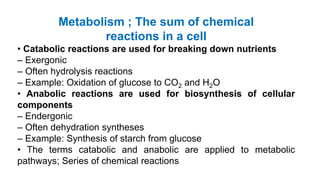
Microbial metabolism.pptx
- 1. Metabolism ; The sum of chemical reactions in a cell • Catabolic reactions are used for breaking down nutrients – Exergonic – Often hydrolysis reactions – Example: Oxidation of glucose to CO2 and H2O • Anabolic reactions are used for biosynthesis of cellular components – Endergonic – Often dehydration syntheses – Example: Synthesis of starch from glucose • The terms catabolic and anabolic are applied to metabolic pathways; Series of chemical reactions
- 3. Microbial Metabolism Why is energy needed? maintain the structural integrity of the cell by repairing any damage to its constituents synthesize new cellular components such as nucleic acids, polysaccharides and enzymes transport certain substances into the cell from its surroundings for the cell to grow and multiply cellular movement. Adenosine triphosphate in metabolism • Catabolic reactions are coupled to dehydration synthesis of ATP from ADP and phosphate • Hydrolysis of ATP to ADP and phosphate is coupled to anabolic reactions
- 5. Central to the metabolic processes of any cell are enzymes. Enzymes Various Types of Prokaryotic Energy Production Processes Fermentation Anaerobic Respiration Aerobic Respiration Lithotrophy: Lithotrophs are a diverse group of organisms using inorganic substrate to obtain reducing equivalents for use in biosynthesis or energy conservation via aerobic or anaerobic respiration Photoheterotrophy: Uses light for energy and cannot use carbon dioxide as their sole carbon source. Anoxygenic photosynthesis: the phototrophic process where light energy is captured and converted to ATP, without the production of oxygen Methanogenesis: Methanogenesis or biomethanation is the formation of methane by microbes known as methanogens
- 6. Enzyme Structure Apoenzyme Protein Allosteric site Cofactor Metal ions Cu Zn Mg Fe Ca Co Mn Coenzyme Vitamins CoA NAD NADP FAD FMN Create Holoenzyme with active site
- 7. Major classes of enzymes Enzyme classification
- 8. Enzymes can be stopped • Conditions that disrupt the 3D shape • Acidic, alkaline, high salt, high temperature, etc. • These conditions thus affect growth of cell also. • Inhibitory molecules affect enzymes • Competitive inhibitors • Fit in active site but are not changed; prevent normal substrate from binding, prevent reaction. • Non-competitive inhibitors • Bind permanently to active site or other site which changes molecular shape; prevents reaction. • Allosteric inhibitor: temporary binding, regulates.
- 9. Competitive Inhibition Both the substrate and the inhibitor fit into the active site, but the inhibitor isn’t altered by the enzyme. As long as the inhibitor is in the active site, the substrate cannot enter the active site and react. The more inhibitor molecules that are present, the more often one of them occupies the active site
- 10. Allosteric sites In allosteric site, inhibitor is not reacted, but causes a shape change in the protein. The substrate no longer fits in the active site, so it is not chemically changed either.
- 11. Competitive Inhibitors -compete for the active site 1. Penicillin – competes for the active site on the enzyme involved in the synthesis of the pentaglycine crossbridge 2. Sulfanilamide (Sulfa Drugs) – competes for the active site on the enzyme that converts PABA into Folic Acid Folic Acid - required for the synthesis of DNA and RNA
- 12. Non-competitive Inhibitors - attach to an allosteric site
- 13. Enzyme lowers the activation energy
- 14. Environmental factors affect enzyme activity Temperature pH
- 15. Substrate concentration Under conditions where the active sites of an enzyme population are not saturated, an increase in substrate concentration will be reflected in a proportional rise in the rate of reaction. The Michaelis—Menten equation relates the rate of a reaction to substrate concentration, [S]: v = Vmax[S] [S] + Km Values of Vmax and Km are more easily determined experimentally by plotting the reciprocals of [S] and V to obtain a straight line
- 16. Enzyme activity is influenced by substrate concentration. The initial rate of reaction (vo) is proportional to substrate concentration at low values of [S]. However, when the active sites of the enzyme molecules become saturated with substrate, a maximum rate of reaction (Vmax) is reached. This cannot be exceeded, no matter how much the value of [S] increases. The curve of the graph fits the Michaelis–Menten equation. Km is the value of [S] where v = Vmax 2 . Some enzymes do not obey Michaelis–Menten kinetics. The activity of allosteric enzymes is regulated by effector molecules which bind at a position separate from the active site. By doing so, they induce a conformational change in the active site that results in activation or inhibition of the enzyme. Thus effector molecules may be of two types, activators or inhibitors.
- 17. Principles of energy generation How enzyme-catalysed reactions are involved in the cellular capture and utilisation of energy. The ‘cash’ of cellular metabolism is a compound called adenosine triphosphate (ATP). ATP has a structure very similar to the nucleotides found in RNA, except it has two additional phosphate groups
- 18. Oxidation Reduction reaction As the lactate is oxidised, so the NAD+ in the coupled reaction is reduced. It is said to act as the electron acceptor. NAD+/NADH is generally involved in catabolic reactions, and NADP+/NADPH in anabolic ones.
- 19. Catabolic pathways in heterotrophs. Pathways for the catabolism of proteins, nucleic acids and lipids as well as carbohydrates can all feed into the tricarboxylic acid cycle
- 20. Embden–Meyerhof pathway, glycolysis is used for the metabolism of simple sugars not just by microorganisms, but by most living cells Entner–Doudoroff pathway, producing a mixture of pyruvate and glyceraldehyde- 3-phosphate One molecule each of ATP, NADH and NADPH per molecule of glucose degraded pentose phosphate pathway, sometimes known as the hexose monophosphate shunt is an other option for glucose metabolism
- 22. The pentose phosphate pathway. Operating simultaneously with glycolysis, the pathway serves as a source of precursors for other metabolic pathways. The metabolic fate of intermediates is indicated in italics. Circled numbers next to each molecule denote the number of carbons